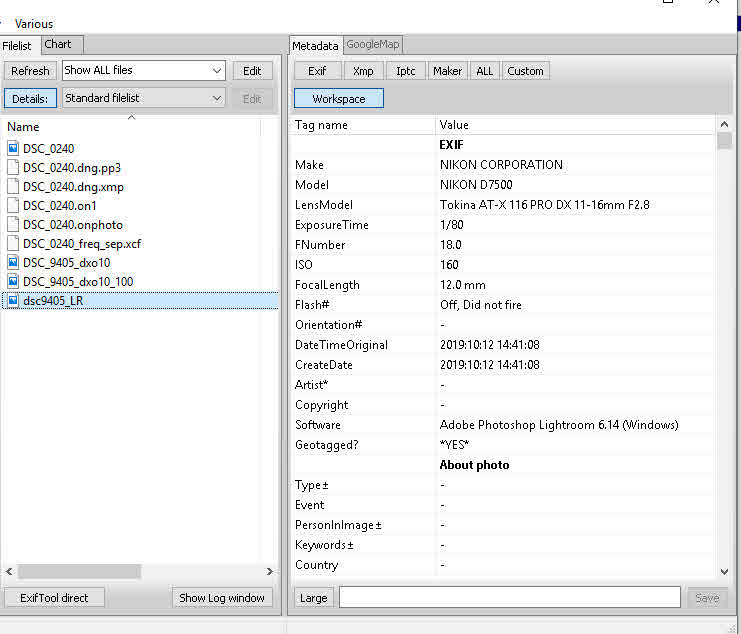
- #How to use exiftool on mac how to
- #How to use exiftool on mac for mac os x
- #How to use exiftool on mac install
- #How to use exiftool on mac pro
- #How to use exiftool on mac software
To remove sensitive personal information and location data.There are many good reasons why you may want to remove EXIF data from your photographs. Below, we’ll cover how and why to remove EXIF data. Some shrewd photographers would also prefer to limit the amount of information other photogs can get from their work. While most EXIF data is innocuous, a bit of it (such as your GPS location information) is sensitive information you may prefer to remove from a photo. Photo by alexx-ego is licensed under CC0 Removing EXIF Data Keep in mind you may not be able to edit every field you see, although you can edit most of them.Įditing or adding EXIF data is as simple as clicking next to the missing or inaccurate value and replacing it with the correct information. The metadata, which includes all the EXIF information, is contained in the six sections below. Making edits or corrections to EXIF data is easy to do from a Windows or Mac PC.įor Windows users, start by right clicking the photo you need to edit and click “Properties.” From there, select the “Details” tab, which will pull up all of the photo’s metadata. Once you’ve selected what data you’d like to export, click the export button from the bottom of the window. Next, you’ll see a metadata field that allows you to choose what metadata the program will export with the photo. You can extract photos while preserving EXIF data using Lightroom or a similar post processing program.įirst, select the photo you’re looking to export from Lightroom, and navigate to the File menu and select “Export.” Then, select the folder you’d like to export the photo to. Preserving EXIF Data When Extracting in Lightroom If you’d prefer to use a website to see EXIF data, there are a few reliable options for that as well, including the sites below.
#How to use exiftool on mac pro
If you need to view EXIF information, but you aren’t interested in downloading a standalone program to get the job done, there are plenty of plug-ins available for popular browsers.Įxif Viewer and Exif Viewer Pro are available on Firefox and Chrome, respectively, and they’re an ideal option if you’re looking for a browser plug-in. Online Metadata Viewers and Browser Plug-ins

#How to use exiftool on mac for mac os x
Simple EXIF Viewer for Mac OS X is an excellent option for Apple users, and it’s free, too. FastStone Image Viewer and EXIF Data Viewer are both free options for Windows PC, and ExifPro is another reliable option, but it does cost $19.95 to register the product.
#How to use exiftool on mac software
There are plenty of great software options available for viewing EXIF metadata, and many of them are free to use. Photo by StockSnap is licensed under CC0 Other Tools for Viewing EXIF Dataīeyond these popular ways for viewing EXIF data, there are a few other handy ways you can access it. Next, navigate to the metadata panel, and select EXIF from the dropdown menu, which will bring up the data for you to view. To view EXIF data in Lightroom, open the Library module within the program. From there, click the “Image” tab in the file explorer window, which will pull up the EXIF data. Right-click on the photo you’re hoping to inspect, and select “Properties” from the dropdown menu.

Viewing EXIF data in Linux is quite similar to viewing it on other operating systems. Select the EXIF tab from the menu, and you’ll be provided with all applicable EXIF data. Navigate to the “Tools” tab in the menu bar and choose “Show Inspector” from the dropdown menu.Ī new window will pop up with more information on the photo. Mac OSįor Mac devices, double-click the photo you’d like to view the data on, which will open it in Preview. Then, select “show properties” and navigate to the “details” tab, which will provide you with EXIF data. Viewing EXIF data in Windows is as easy as right-clicking a photo.
#How to use exiftool on mac how to
How to View EXIF Data in OS and with a Photo Viewerįor viewing EXIF data from photos saved to your computer, or if you’d prefer not to download a browser extension, you can use the tools that are built into your operating system. Then, you can right click on any photo and view EXIF data from the dropdown menu, right at home in your browser.
#How to use exiftool on mac install
Download and install the “EXIF view” plug-in from the app store and restart your browser. How to View EXIF Data in Chromeįor viewing EXIF data in Chrome, the process is nearly identical. EXIF info will be available once you open the viewer. Remember that this tool doesn’t work with thumbnail images you’ll need to click through and bring up the full-size image to view the data. To view EXIF data, right click on any photograph, and select “EXIF viewer” from the menu. Download the EXIF viewer add-on, and restart your browser once the download is complete.

Viewing EXIF data in Firefox is relatively easy with the help of a simple plug-in. Photo by TheAngryTeddy licensed under CC0 How to View EXIF Data in Firefox


 0 kommentar(er)
0 kommentar(er)
